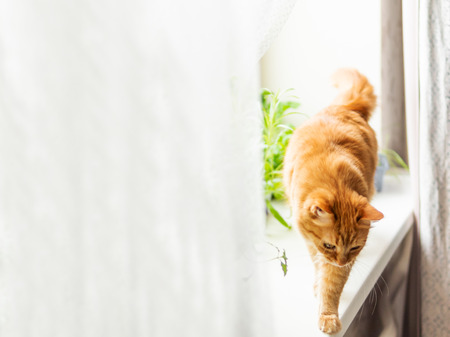Understanding Cat Allergens in UK Homes
For many Britons, sharing a home with a feline companion is a cherished part of daily life. However, cat allergens—particularly those originating from fur and dander—pose significant challenges to households across the UK. These allergens are microscopic proteins found primarily in cat saliva, skin flakes (dander), and sebaceous glands, which become airborne as cats groom themselves and shed their coats. When inhaled or deposited on household surfaces, these particles can trigger allergic reactions ranging from mild sneezing to more severe asthma symptoms.
In the United Kingdom, studies estimate that up to 8% of households experience allergic reactions directly linked to cat ownership. This figure may be even higher in densely populated urban centres like London or Manchester, where limited ventilation and smaller living spaces contribute to higher concentrations of indoor allergens. The UKs famously damp climate further complicates matters by encouraging indoor living for both pets and humans during much of the year, allowing allergen levels to build up within carpets, soft furnishings, and bedding.
Additionally, British homes often feature central heating systems and double glazing, which—while excellent for retaining warmth—can inadvertently reduce air circulation and trap allergens indoors. Understanding these unique environmental factors is essential for UK cat owners seeking practical solutions to minimise the impact of allergens while enjoying the companionship of their beloved moggies.
2. Choosing the Right Grooming Tools
When it comes to reducing allergens from cat fur, UK feline care professionals stress the importance of selecting grooming tools tailored to your cat’s breed and the unique climate conditions found across Britain. The damp British weather can influence shedding cycles and matting, so choosing the right brush or comb is essential for both your cat’s comfort and effective allergen control.
Advice from UK Feline Care Experts
British cat breeds like the British Shorthair, Scottish Fold, or even long-haired Persians require different grooming approaches. According to local groomers, a slicker brush is perfect for removing loose hair from shorthairs, while a wide-toothed comb is better suited for long-haired breeds prone to tangling. Rubber grooming mitts are also popular in the UK for sensitive cats or kittens as they mimic petting and help relax nervous felines during grooming sessions.
Recommended Grooming Tools by Cat Breed and Purpose
| Cat Breed/Coat Type | Recommended Tool | Purpose | Expert Tip |
|---|---|---|---|
| British Shorthair | Slicker Brush | Removes loose fur & reduces shedding | Brush 1-2 times weekly, especially during spring moulting season |
| Persian/Longhair Breeds | Wide-Tooth Comb + Dematting Rake | Detangles mats & prevents undercoat build-up | Daily gentle combing helps avoid painful mats common in damp climates |
| Bengal/Short Slick Coats | Rubber Grooming Mitt | Lifts dander & stimulates skin oils | Use in circular motions for a soothing experience, ideal for sensitive cats |
| Elderly or Sensitive Cats | Bristle Brush (Soft) | Cleanses coat without irritation | Select natural bristles for less static during dry winter months indoors |
Local Climate Considerations for Grooming in the UK
The fluctuating humidity and temperature in Britain mean cats can shed unpredictably throughout the year. Professionals suggest increasing brushing frequency during autumn and spring when indoor heating or outdoor dampness may exacerbate shedding and matting. Always ensure tools are cleaned after each use to prevent allergen build-up and maintain effectiveness.

3. Recommended Grooming Routines
Step-by-Step Cat Grooming for UK Households
Establishing a grooming routine that fits into the typical UK lifestyle is essential for reducing cat fur allergens. Whether you live in a cosy London flat or a countryside cottage, these step-by-step tips can help minimise allergen spread and keep both you and your feline friend comfortable.
Step 1: Choose the Right Time and Place
Select a quiet space with minimal distractions—ideally a warm, well-lit room. Many UK cat owners find early evenings most suitable, when their pet is naturally calmer.
Step 2: Gather the Essentials
Invest in a quality slicker brush or deshedding tool, hypoallergenic wipes, and a soft towel. Local pet shops across the UK often stock products recommended by British vets. Keep treats handy to positively reinforce your cat’s cooperation.
Step 3: Regular Brushing Sessions
Brush your cat at least two to three times per week for short-haired breeds, and daily for long-haired varieties like the British Longhair. Use gentle strokes starting from the head and moving towards the tail, paying extra attention to areas where fur mats easily (behind the ears and underarms). This helps remove loose fur before it becomes airborne.
Step 4: Wipe Down to Reduce Allergens
After brushing, use an unscented, hypoallergenic pet wipe to gently clean your cat’s coat. This removes dander and further reduces allergen build-up—a tip favoured by many UK veterinary nurses.
Step 5: Clean Up Thoroughly
Dispose of collected fur outdoors or in a sealed bin. Wash grooming tools regularly using pet-safe disinfectant. Vacuum and dust the grooming area promptly; vacuum cleaners with HEPA filters are widely recommended across the UK for trapping allergens.
Consistency Is Key
Sticking to this routine not only controls allergen spread but also strengthens your bond with your cat. UK experts agree that integrating grooming into your weekly schedule—perhaps after your Sunday roast or during weekday wind-downs—can make the practice feel less like a chore and more like a cherished ritual.
4. Reducing Allergens During and After Grooming
Keeping airborne allergens to a minimum during your cat’s grooming sessions is essential, especially for allergy-prone households. British experts recommend a few practical steps that can make a world of difference in your daily routine. Below, we’ll cover the top tips for reducing allergens both while you’re grooming your cat and during the crucial clean-up afterwards.
Tips for Minimising Airborne Allergens While Grooming
- Choose the Right Spot: Groom your cat in a well-ventilated area, ideally with windows open or an air purifier running. Outdoor spaces like gardens are excellent if your cat is comfortable outside and it’s safe to do so.
- Dampen the Fur: Lightly mist your cat’s coat with water or a pet-safe grooming spray before brushing. This helps trap loose dander and fur, stopping it from floating into the air—a tip often suggested by UK veterinary nurses.
- Use HEPA Filtration: If you groom indoors, consider using a vacuum cleaner equipped with a HEPA filter nearby to catch airborne particles as they’re released.
- Wear Protective Clothing: Don an old shirt or overalls dedicated to grooming time, which can be removed and washed immediately after to avoid spreading allergens throughout your home.
Safe Cleaning Practices Post-Grooming
The clean-up after grooming is just as important as the session itself. Here are recommended actions based on advice from British pet care professionals:
| Cleaning Task | Recommended Practice |
|---|---|
| Launder fabrics | Wash grooming towels and any clothing worn using hot water and non-bio detergent. |
| Vacuum floors & furniture | Use a vacuum cleaner with a HEPA filter to remove fur and dander from carpets, sofas, and curtains. |
| Mop hard surfaces | Mop floors and wipe down surfaces near the grooming area with a damp cloth to pick up fine particles. |
| Dispose of waste | Seal collected fur and used wipes in a bag before placing them in the bin to prevent re-release of allergens. |
| Airing out | If possible, open windows for at least 30 minutes after grooming to help disperse lingering allergens. |
Expert Tip: Personal Hygiene Matters Too!
Bathe hands and face thoroughly after each session, as dander can cling to skin and hair. Many UK vets also advise rinsing eyes if you’re prone to allergies. Adopting these simple habits will help keep your home more comfortable for everyone—including those sensitive to cats.
5. Additional Household Measures for Allergy Relief
While regular grooming is crucial for reducing cat allergens, maintaining an allergen-reduced home environment is equally important—especially in the UK, where many households rely on central heating and have carpets that can trap allergens. UK experts recommend adopting a multi-pronged approach to keeping your living space as allergy-friendly as possible.
Cleaning Tips Tailored for UK Homes
Vacuuming with a HEPA-filter vacuum cleaner at least twice a week is highly recommended. British homes often feature fitted carpets and soft furnishings, which can harbour cat dander. Regularly washing throws, cushion covers, and curtains at 60°C helps break down allergens. Hard flooring such as laminate or wood is easier to keep allergen-free than traditional carpeting, so consider swapping out rugs where possible.
Air Filtration & Ventilation
Because UK weather often means windows are closed for much of the year, using portable air purifiers with HEPA filters in key rooms—particularly bedrooms and lounges—can make a significant difference. Make sure to service your homes ventilation systems regularly and open windows on milder days to improve air exchange. Avoid smoking indoors, as this can worsen allergic reactions by irritating respiratory passages.
Practical Lifestyle Adjustments
Assigning ‘cat-free zones’ in your home (especially bedrooms) is a practical step endorsed by UK allergy specialists. Also, encourage frequent handwashing after petting or grooming your cat, and change clothing if you’ve had close contact. Keep your cat’s bedding clean and situated in easy-to-clean areas rather than plush corners or upholstered furniture. For households with children or immunocompromised members, these strategies can be especially beneficial in managing symptoms day-to-day.
Professional Advice & Support
If allergies persist despite these measures, consult your local GP or an NHS allergy clinic for personalised guidance. Many UK pharmacies also offer over-the-counter solutions and advice tailored to common household allergens from pets.
Summary
By combining expert grooming practices with these UK-specific household adjustments, you can create a more comfortable living environment for both you and your feline companion while minimising exposure to troublesome allergens.
6. Expert Advice and UK Resources
Insights from Leading UK Cat Care Professionals
Veterinarians and cat care specialists across the UK consistently emphasise the importance of regular grooming in reducing allergens from your cat’s fur. According to the British Veterinary Association, weekly brushing with a suitable brush for your cat’s coat type can significantly minimise loose dander and hair, which are key sources of allergens. Grooming also provides an opportunity to check for skin conditions or parasites that could exacerbate allergies.
Connecting with Local Support Networks
The UK boasts a variety of local resources to help cat owners manage allergies effectively. Organisations such as Cats Protection offer advice lines and online guides specifically tailored to allergy management in multi-cat households. The PDSA (People’s Dispensary for Sick Animals) also provides practical workshops and leaflets on grooming techniques that reduce allergen levels.
Recommended Reading and Further Guidance
If you’re seeking deeper knowledge, several UK-based publications come highly recommended by feline experts. “The Cat Owner’s Manual” by Dr. David Brunner and “Cat Sense” by John Bradshaw include dedicated sections on managing allergies through grooming routines. Additionally, websites like International Cat Care regularly update their advice based on the latest research.
Joining Online Communities
Don’t overlook the value of connecting with other cat owners facing similar challenges. Online forums such as Mumsnet’s pet section and the Cats Protection Facebook group provide platforms to share experiences, seek recommendations for hypoallergenic products, and receive support from those who understand the unique bond between cats and their humans.
By taking advantage of these expert insights and local resources, UK cat owners can create a more comfortable home environment—both for themselves and their feline companions—while keeping allergen levels in check.


